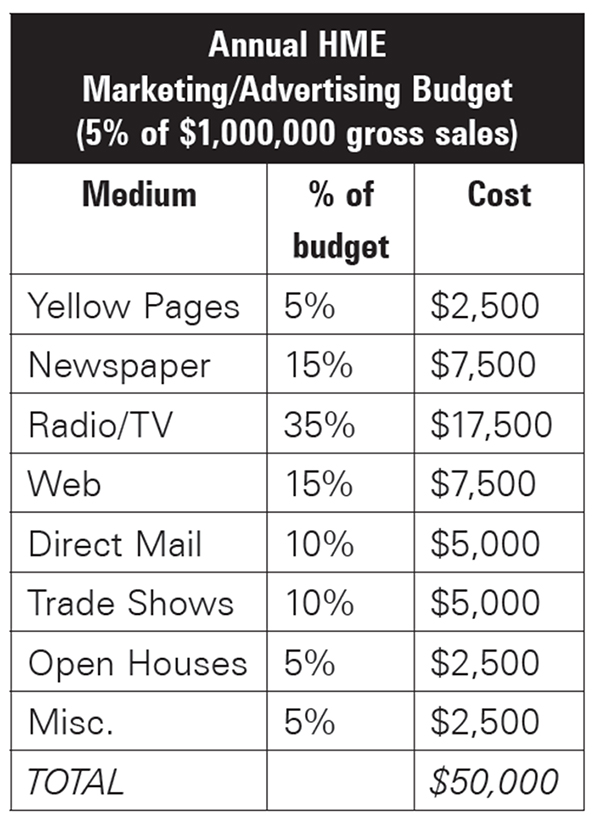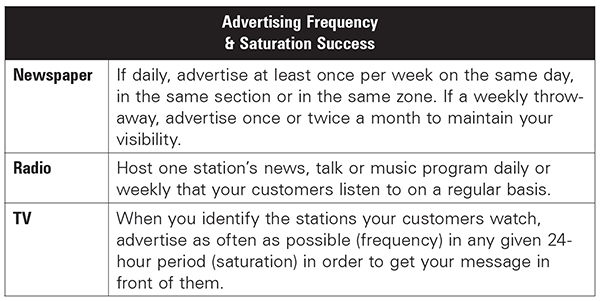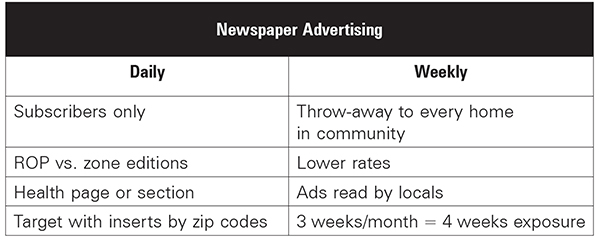 Successful HME TV commercial breakdown. Click to enlarge.
Successful HME TV commercial breakdown. Click to enlarge.
Home health care (HHC) products are selling as impulse products on TV commercials, infomercials and cable shopping networks. Unfortunately, our industry still focuses daily on medical necessity reimbursable products. But when you make the commitment to expand into retail, you begin selling retail products to retail consumers. And advertising is the lifeblood of any retail business. For a retail business to establish its brand and generate sales from new customers, advertising must be frequent enough to saturate a given market. This generally means utilizing print ads two or three times per month, radio ads alternating weeks or months and/or TV ads two to three weeks per month. The average advertising budget of a retail HHC business ranges between $800 and $1,500 per month, depending upon their respective monthly sales and the sizes of their sales territories. So few HHC businesses are operating as retail businesses—and advertising on a continuous basis like other retailers—that these select market leaders have become their local destinations in HHC and are selling everything they advertise. These retail HHC businesses must discover what works in advertising.

Not a One-Time Event
To be successful, any advertising effort requires a strategic plan. One print ad will not be profitable when statistically consumers need to see your message a minimum of four to six times before they even think about responding.
- Some guidelines to consider are:
- Advertising must be a long-term commitment, not a short-term expense.
- Identify your customer demographics and then target them to successfully clone and grow your customer base (the Starbucks approach).
- Successful mass media advertising is a direct result of saturation and frequency, which requires an advertising program over a period of weeks and/or months.
- Television enables independents to compete successfully against the chains because you have the same 30 seconds to sell yourself.
Differentiate Yourself
- What is unique about your business in contrast with your competition? Make lists of your strengths and weaknesses and of your competition’s as well, and then determine why customers return to buy from you over and over again. Take this strength and turn it into your identity that you promote on a daily basis via marketing and advertising. Your corporate shell represents this identity and includes your name, logo and tag line. Your logo is a graphic and colorful representation of your name. Your tag line is a short phrase of three to five words that is presented with your logo and captures your uniqueness. A few examples of HHC tag lines include: We Treat You Like Family; We Care About Your Health; Caring for Your Health & Wellness; We Serve and Care for Our Community.
Identify Your Customer Demographics
Who are your current customers? By identifying their age, sex and zip codes, you can then determine which medium(s) to utilize to target them via marketing and advertising. And once you know your current customer base, you will be able to attract potential customers as well by expanding this base. Note that similar people like similar attributes of businesses, brands, and their related products. One approach to demographic advertising is to simply ask all of your current customers to name their favorite newspaper, TV station and/or radio station. Or once you have identified your customer demographics, you can request media kits from any newspaper, TV station and radio station. Then compare your customer base with each medium’s customers (readers, subscribers, viewers or listeners) and select the top two or three closest matches to start advertising.
Track Your Ads
It is not given that all advertising will be successful. Advertisers need to track their ads in order to see which ones respond best or generate the highest number of customers and sales. Request that all employees ask everyone who calls or comes into the store: 1) How they heard about your store; 2) Where they saw or heard your ad; and 3) How they found out about your store (as you read through a short list of newspapers, TV stations, and/or radio stations where you are currently advertising). In television advertising, advertisers usually run commercials on more than one station to broaden their reach when targeting a specific demographic. If an HHC retailer is targeting family caregivers who are females between 45 and 55 years old, then after reading through the demographic summaries for cable stations they might pick five or six of the closest matches. Depending upon where you are located in the country and whether your sales territory is urban or rural, these stations would probably include a news station such as CNN or Fox News plus A&E, Discovery, Food Network, HGTV, Lifetime, Oxygen and TNT. Start by trying two news stations to see which one generates the most traffic and sales. Then keep the top news station and start with one of the other cable stations. Every two weeks, rotate in a second cable station to determine which one works as well as the news station in attracting customers. After a few months, you will know the top two or three stations on which to advertise and produce a profitable TV ad campaign—but only if you track these results on a daily basis.
Frequency and Saturation
The next step in successful media advertising is to negotiate contracts with the newspaper, radio station or TV stations that produce the highest response from your current and potential customers. Media salespeople usually talk about frequency and saturation when selling advertising. This translates into how often your ad will be seen or heard in their medium and if you are making enough impressions (the number of times a person sees or hears your ads) to motivate consumers to respond.

Print Ad Winners
Newspaper advertising was once the primary medium for HME businesses, and many still advertise weekly or monthly in their local newspapers. They usually run single-product or multi-product ads that sell products at special price points. These ads highlight either one high-ticket product (focusing on a high profit category) or also include 4-12 lower-priced products to generate higher retail traffic. The more products you offer, the more people you will appeal to and motivate to respond. Note that there is a definite difference between advertising in daily or weekly newspapers (see below chart). Due to the dwindling subscriber base for daily newspapers (as consumers gravitate online for their news), so few households in any given community still receive a daily newspaper that the advertising costs often outweigh the response. In contrast, weekly throwaway newspapers are usually delivered to all addresses within any given community so offer a cost-effective means to reach every household.

For targeting specific demographic groups within any given zip code, two print options work well: weekly throwaways within those communities and inserts within daily newspapers that are only sent to specific zip codes. Inserts actually cost less than display ads, and extra copies can be printed and utilized for referral marketing, in-store handouts and direct mail pieces. Print ads have also proven to be effective promos when HHC retailers are hosting special events such as open houses or clinics. The most popular events include a diabetes health day (with a nutritionist to provide healthy recipes and free lunch), a leg health day for compression, a joint health day for orthopedic supports, and a wheelchair tune-up or free wash day for mobility.
Heard on the Radio
In radio advertising, successful advertisers are able to talk one-on-one with their listeners to avoid being tuned out. Many promote active listening by using a known radio personality and don’t write a set script. These advertisers just let the announcer talk naturally to listeners and play off their familiarity with that program, radio personality and station. Most HHC radio advertisers sponsor health-related shows or news items to tie-in their health-related ads that immediately follow. The goal is for listeners to establish the relationship between the HHC business sponsor and all related home health care issues. Other HHC advertisers create their own mini-health news casts and constantly remind listeners about good health practices at home and with their families.
As Seen on TV
In TV advertising, successful HHC advertisers say and show their product’s personal benefits in as many ways as they can. They show the product in action in order to hook the viewer, while using a voice-over narration to repeat the personal benefits. These ads are homespun, captivating and repetitive. These spots succeed because they stimulate memory, action and sales. Television has become the golden medium for selling HME. Viewers are able to see a demonstration of the personal benefits they or their loved ones will enjoy when they buy and use these products. Whether they are watching a simple commercial, a longer infomercial or a segment on a cable shopping network, consumers can instantly see if and how they will benefit from buying what your are selling. HHC businesses have found that TV advertising is the medium that most successfully builds their community image. Their customers are always coming in and delivering compliments on how they are doing (living up to what services and benefits they are advertising). Customers see the lives of real people being improved by HHC products, and know that they too can benefit. The next step in successful media advertising is to negotiate contracts with the stations that run the programs most watched by your customers. Advertisers on contracts usually buy run-of-station (ROS) spots at discounted or two-for-one rates because these spots are run any time the station needs fillers—which most often is during the late-night and early-morning hours. They also run spots grouped into two or three days per week—one week on, one week off—to saturate the respective stations and reach their targeted audience.
- A few other pointers for TV advertising:
- TV stations and cable networks usually want you to spread out spots over seven days, but don’t do this.
- Concentrate your spots in a two- to three-day period to achieve saturation.
- Select at least one weekday and one weekend day, so either Friday/Saturday or Sunday/Monday, and run as many spots as possible (aim for 10-20 daily).
- ROS is typically the best option, because you get prime time as well as late-night and early-morning spots for a packaged rate. Whereas prime time will cost $40-plus per spot, ROS can cost less than $5 per spot.
- Most seniors watch early-morning TV, while caregivers watch prime time.
- In most areas, HHC businesses spend $10-$20 for a 30-second spot. To be profitable, $40-$50 is the max you would spend and these few targeted spots would be for prime time top programs and time periods.
- Start with two stations, one for news and one for entertainment.
- You will know the first week if you are generating sales. Ask every customer how they heard about your store or sale!
- Drop the weakest station/network every two to three weeks and replace with another until you have narrowed down the best station/network on which to advertise.
- Produce several “centers” for a “donut” spot featuring different key products that your respective vendors will co-op with you to enable you to run more frequently (average 3 to 5 percent of purchases, or sometimes 50 percent of specific ads).
Remember that advertising takes commitment and time. Don’t try any medium once and give up. Develop a strategic plan and stick with it. Your advertising will ultimately drive your retail business, so be the “King of HME” in your hometown!
- What is unique about your business in contrast with your competition? Make lists of your strengths and weaknesses and of your competition’s as well, and then determine why customers return to buy from you over and over again. Take this strength and turn it into your identity that you promote on a daily basis via marketing and advertising. Your corporate shell represents this identity and includes your name, logo and tag line. Your logo is a graphic and colorful representation of your name. Your tag line is a short phrase of three to five words that is presented with your logo and captures your uniqueness. A few examples of HHC tag lines include: We Treat You Like Family; We Care About Your Health; Caring for Your Health & Wellness; We Serve and Care for Our Community.




